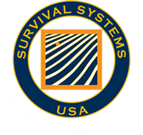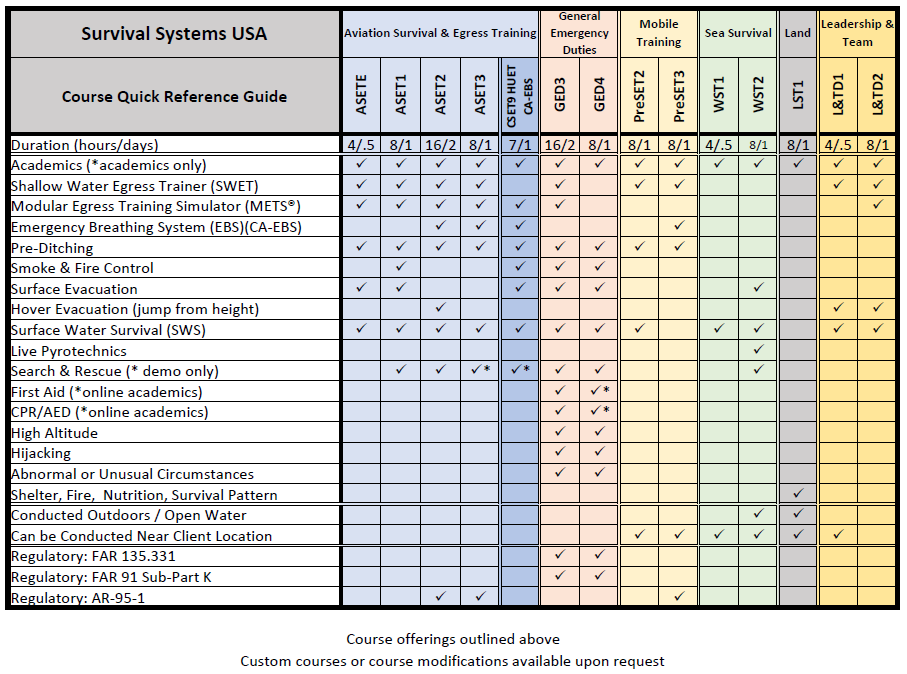The Reference Guide provides a side-by-side course comparison to quickly find a course that fits your organization’s needs. Course names are organized across the top and course topics down the left side of the Guide. Below the Guide is a more detailed look at the topics comprising our courses.
Course durations range from a half-day long to multiple days.
Classroom-based lectures and discussions cover the knowledge needed to perform the skills associated with a selected course.
Shallow Water Egress Trainer (SWET)
Equipment used in the shallow end of the pool to learn basic underwater escape procedures dealing with seat belts, brace positions, reference points, and exits.
Modular Egress Training Simulator (METS®)
Escape a sinking helicopter.
Equipment used in the deep end of the pool to build upon basic egress principles, induce disorientation, and simulate real-life emergency aircraft escape conditions.
Emergency Breathing System (EBS)
Equipment is used to assist crew members or passengers with breathing as they escape a sinking helicopter. Training includes avoiding barotrauma injuries, pressure effects on the human body and equipment, EBS preflight inspection, clearing, and breathing with EBS in the SWET or METS®.
Procedures aircraft occupants should follow before impact and when ditching is imminent. Training includes stowage of loose articles, life vest preparation, seat belt check, reaffirming exit, and brace positions.
Equipment and procedures used to evacuate smoke and extinguish fires. Training includes selecting personal protective equipment, emergency communication, and using portable fire extinguishers on a live fire.
Procedures for disembarking an aircraft after it has stopped moving but before submerging. Training includes identifying hazards, crewmember duties, responsibilities, and emergency coordination.
Procedures for evacuating a helicopter while still in flight. Training includes identifying hazards of evacuating from a height and body positioning during free fall.
Procedures for surviving the hazards associated with an open water environment. Training includes using life vests, immersion suits, travel formations, life rafts, and a survival pattern to mitigate the effects of hypothermia.
Equipment used by survivors to signal nearby aircraft or boaters. Training includes the use of live pyrotechnics in an open-water environment.
Equipment deployed by helicopters to rescue survivors from an open water environment. Training includes recognition of commonly used rescue devices, hazards, and procedures to follow while being rescued.
Nationally Accredited First Aid, CPR, & AED Training
Training to help participants recognize and respond appropriately to cardiac, breathing, and first aid emergencies. Participants learn how to care immediately for a suddenly injured or ill person until more advanced medical personnel arrive and take over.
Procedures for in-flight emergencies at higher altitudes (above 25,000 feet). The training covers respiration, hypoxia, emergency breathing systems, oxygen delivery systems, gas expansion, gas bubble formation, and decompression incidents.
Procedures for responding to a hijacking scenario.
Abnormal or Unusual Circumstances
Procedures for dealing with pregnancy and emergency delivery onboard an aircraft.
Shelter, Fire, Nutrition, Survival Pattern
Equipment and procedures used by survivors in the wild. Training includes survival psychology, survival patterns, hypothermia mitigation, hyperthermia mitigation, topography, basic seas ice descriptions, equipment and clothing requirements, first aid, shelter construction, rescue signaling, fire construction techniques, food, and water procurement, map and compass use, and land navigation.
Courses are conducted outdoors, where students are subject to New England seasons, or in our temperature-controlled training environment. Immersion suits are provided for open watercourses.
Can be conducted Near Client's Location
Courses can be conducted near client locations as a cost-effective solution for organizations that neither have the available travel funds nor the ability to lose team members for travel due to training.
Courses comply with government regulations through multiple accreditation institutions and offer a standardized level of training.
Course offerings outlined above
Custom courses or modifications available upon request

860-405-0002 * 888-386-5371
Survival Systems USA, Inc.
144 Tower Avenue Groton, CT 06340
sales@survivalsystemsinc.com

